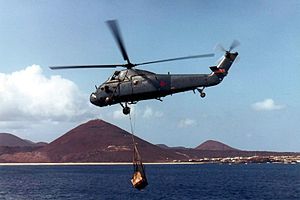
The 1982 British military campaign to recapture the Falkland Islands depended on complex logistical arrangements. The logistical difficulties of operating 7,000 nautical miles (8,100 mi; 13,000 km) from home were formidable. The Argentine invasion of the Falkland Islands came at a time when the Royal Navy was experiencing a reduction in its amphibious capability, but it still possessed the aircraft carriers HMS Hermes and Invincible, the landing platform dock (LPD) ships HMS Fearless and Intrepid, and six landing ship logistics (LSL) ships. To provide the necessary logistic support, the Royal Navy's ships were augmented by ships taken up from trade (STUFT).
The British Army and Royal Navy developed a base at Ascension Island, a British territory in the mid-Atlantic 3,700 nautical miles (4,300 mi; 6,900 km) from the UK and 3,300 nautical miles (3,800 mi; 6,100 km) from the Falkland Islands. Although it had an airfield with an excellent runway, there was only a small hardstand area for parking aircraft and no parallel taxiways. There was an anchorage, but no port facilities—just a lone jetty. Ascension was used as a convenient place for the amphibious ships to re-stow their equipment, and as a base for Hercules transport aircraft, which were modified by the addition of auxiliary fuel tanks and aerial refuelling probes. With the support of Victor tankers, these modifications allowed the transports to deliver priority supplies to the South Atlantic.
The 3rd Commando Brigade landed at Ajax Bay, Port San Carlos and San Carlos on East Falkland, but struggled to build up its supplies as the Argentine air forces made repeated attacks on ships in Falkland Sound. SS Atlantic Conveyor was struck by two Exocet AM39 missiles, and sank with three Chinook and six Wessex helicopters still on board, along with their tools and spare parts, and other vital stores including tent accommodation. The loss of the helicopters on Atlantic Conveyor was a serious blow; it forced the 3rd Commando Brigade to make a loaded march across East Falkland. The Brigade Maintenance Area (BMA) was struck by an Argentine air attack on 27 May that destroyed hundreds of rounds of mortar and artillery ammunition. Forward Brigade Maintenance Areas (FBMAs) were established at Teal Inlet for the 3rd Commando Brigade and Fitzroy for the 5th Infantry Brigade. Some 500 rounds per gun were delivered to gun positions by helicopters to enable the artillery to support the attacks on the mountains ringing Port Stanley. The successful conclusion of these battles resulted in the surrender of the Argentine forces in the Falklands on 14 June.